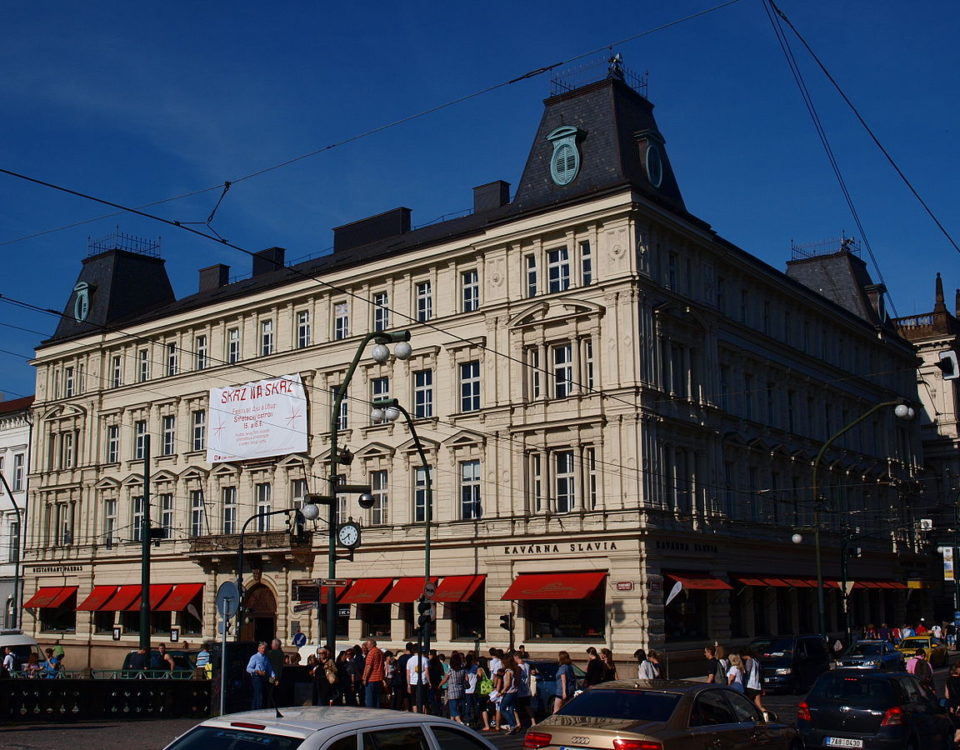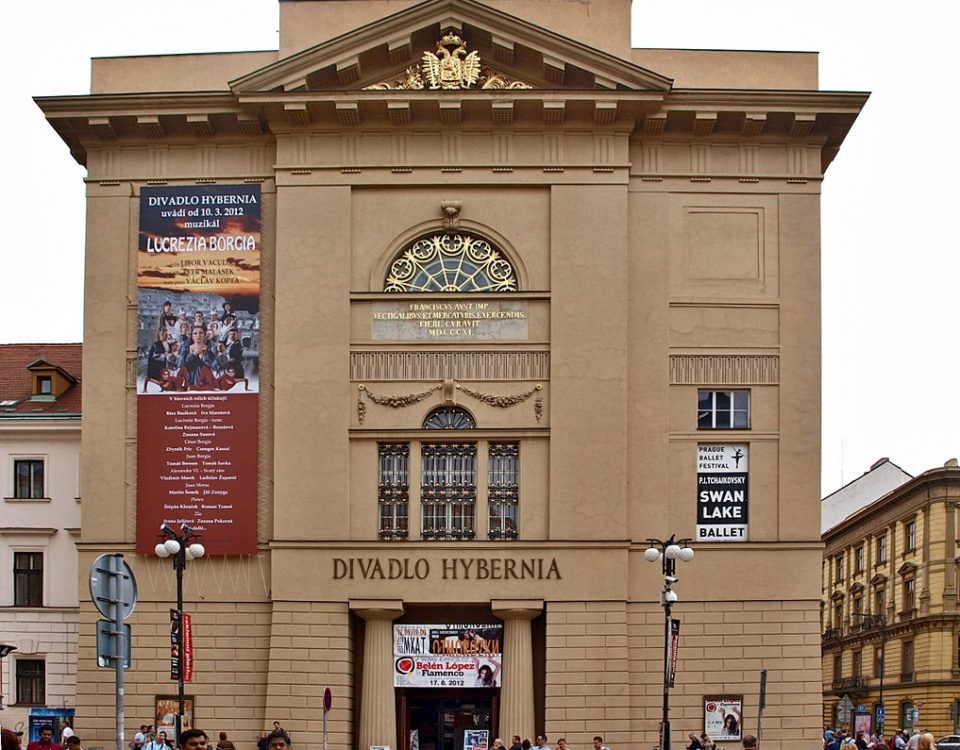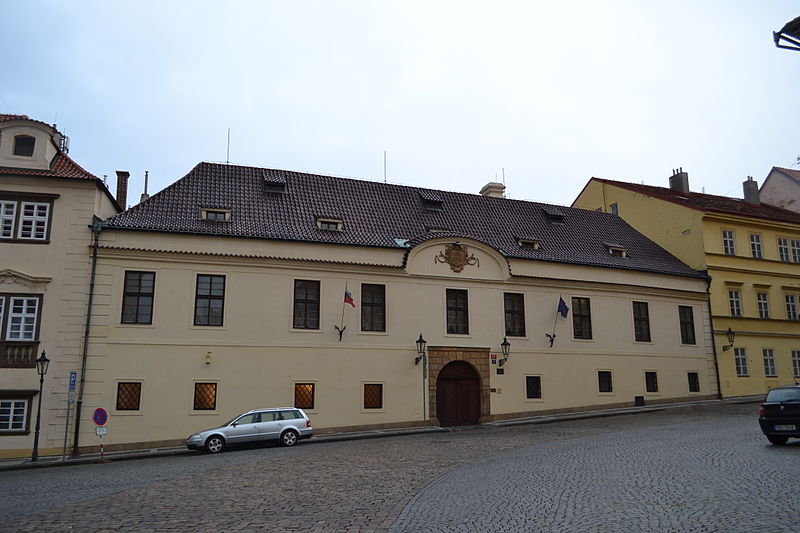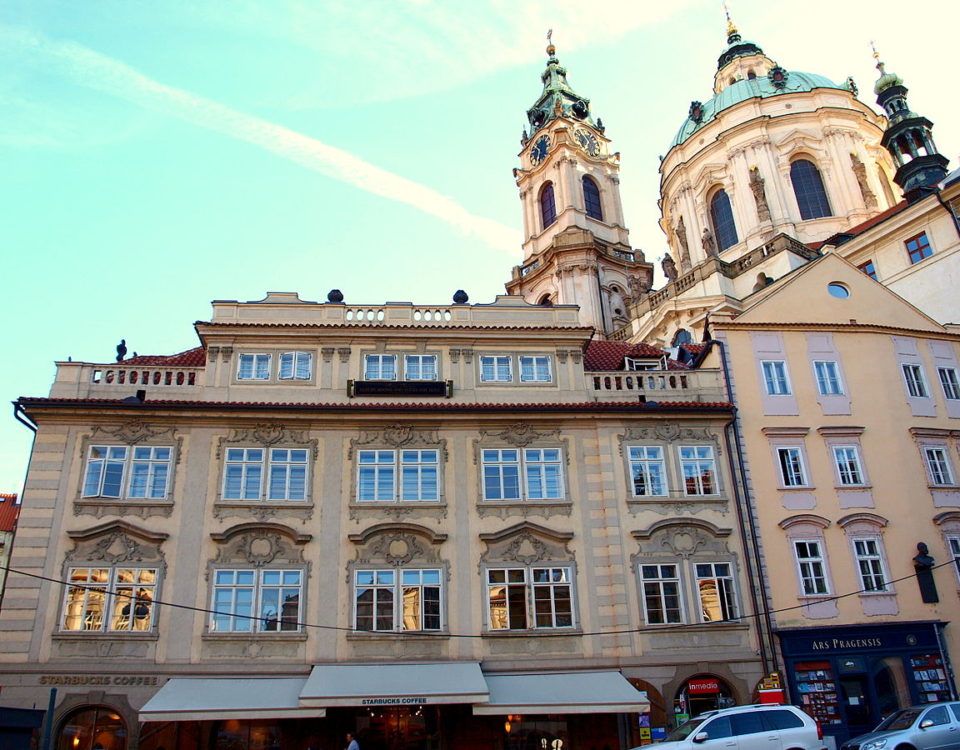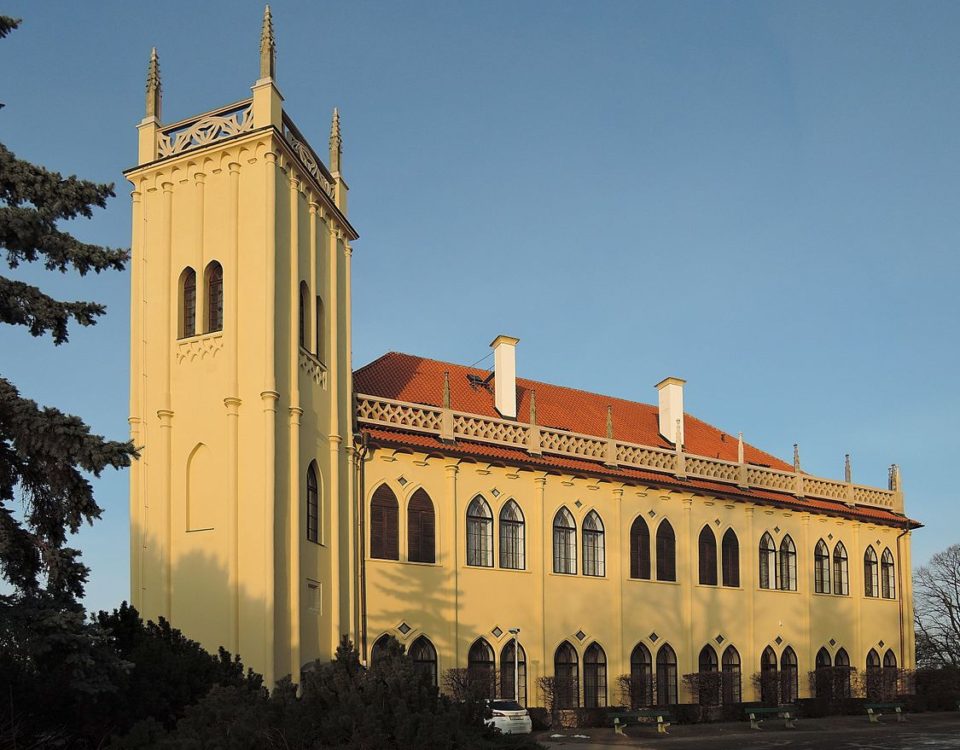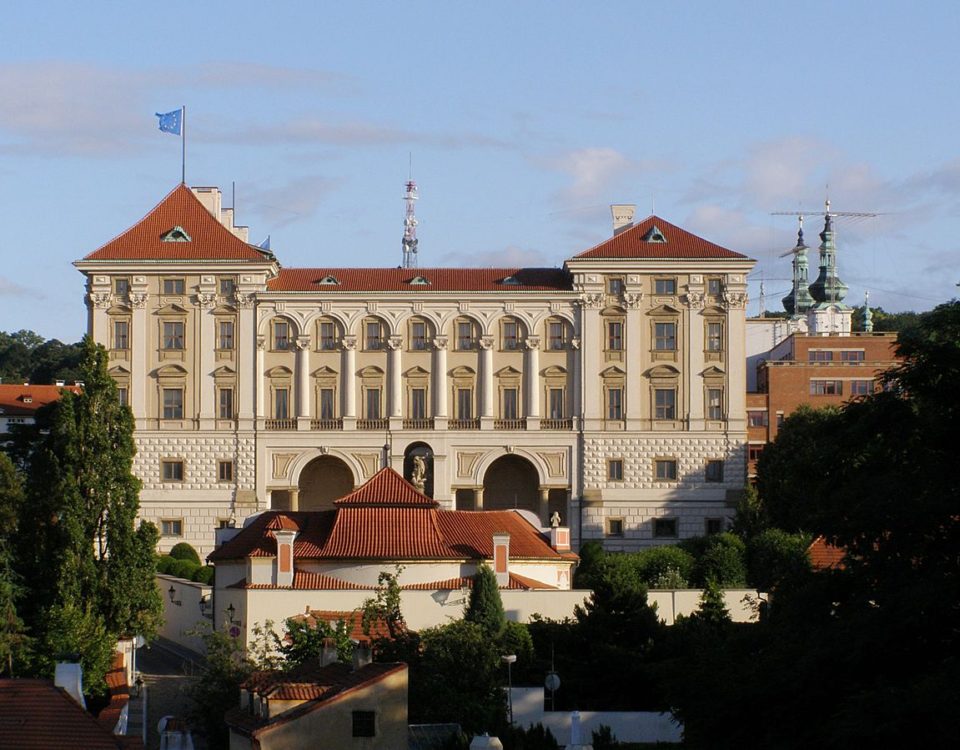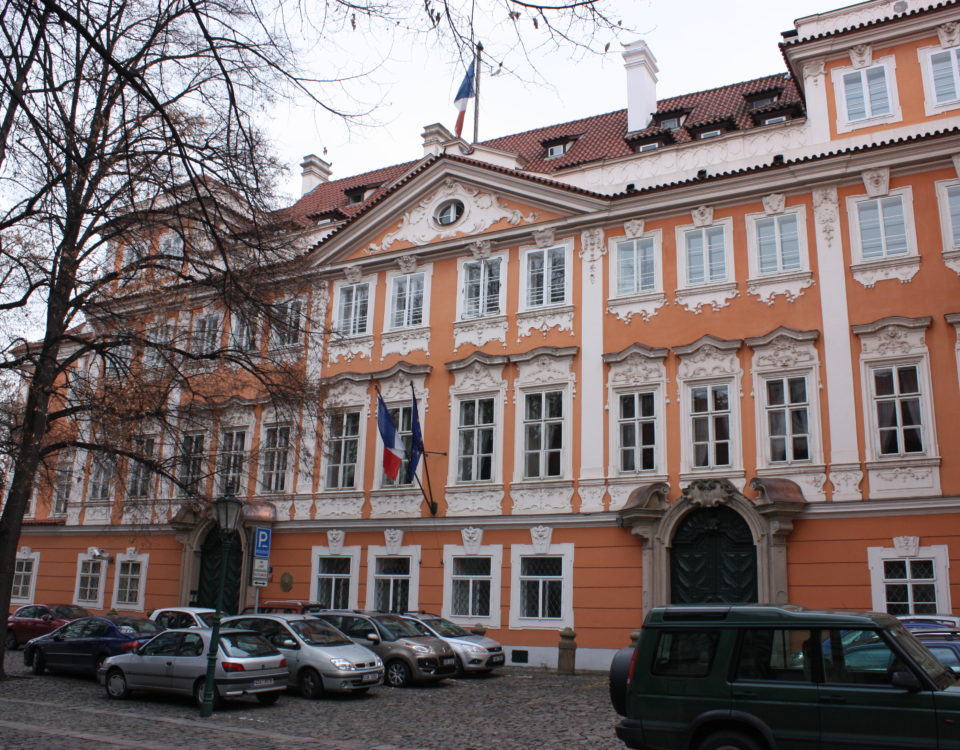December 5, 2018
This monumental neo-Renaissance palace for Count Prokop Lažanský was erected between 1861 and 1863. It’s one of the last Prague palaces that were designed as a combination of a representative noble residence, an apartment building, and administrative space. The building is most famous for the legendary Slavia Café, which became a traditional meeting place for artists and intellectuals soon after it opened. Visitors can enjoy the beautiful views of Prague Castle and the Vltava River over a cup of coffee. Contacts Lažanský Palace (Palác Lažanských) Smetanovo nábřeží 2 / Národní 1 110 00 Praha 1- Staré Město Object history Lažanský Palace is located on the corner of today’s streets Národní třída and Smetanovo nábřeží. In the 14th century, it used to be a spa called Painted (Malovaná), later on it was purchased by the Order of Crusaders with the Red Star, who established a St. Agnes Hospital here […]
December 5, 2018
Renowned musical theatre housed in the U Hybernů building, built in eye-catching Empire style. Thanks to its location in the historical centre of Prague, the theatre also hosts exceptional concerts, balls, and prestigious cultural events. Contacts Hybernia Theatre (Divadlo Hybernia) náměstí Republiky 4 110 00 Praha 1- Nové Město +420 221 419 420 http://www.hybernia.eu vstupenky@hybernia.eu Object history U HYBERNŮ PALACE HISTORY FROM THE MIDDLE AGES UNTIL THE ABOLITION OF THE MONASTERY Shortly after founding the New Town (Nové Město – 1348), Charles IV placed a Benedictine monastery of St. Ambrosius here. In 1630, Emperor Ferdinand II passed the property to the Irish Franciscans, who were expelled from Britain by Queen Elisabeth and dwelled in the Netherlands, from where the Emperor invited them to our country. The monks were called “hyberni” after the Latin name for Ireland – Hibernia (thanks to them we were first introduced […]
December 5, 2018
Hrzánský Palace is a complex of adjoining buildings, which runs along the edge of the Hradčany (Prague Castle) promontory. Currently the palace is used for official functions by the Prime Minister of the Czech Republic. Contacts Hrzánský Palace Loretánská 177/9 118 00 Praha 1- Hradčany https://www.vlada.cz/cz/urad-vlady/dalsi-objekty/hrzansky-palac-3689/tmplid-47/ Object history Neither the exact date of its construction nor the name of its architect are known. In 1359 it was purchased by Petr Parléř, the sculptor and principal builder of St. Vitus’ Cathedral. The Meissen burgrave and Supreme Chancellor of Bohemia Jindřich of Plavno build another section which was acquired from his heirs by Jindřich Mikuláš of Lobkovice, but it was its next owner, Adam the Elder of Šternberk, who refurbished it between 1588 and 1600. Further improvements were made by the Supreme Gentleman of the Chamber Oldřich Desiderius Pruskovský of Pruskov, who had […]
December 5, 2018
This palace, built for the lawyer Karel of Grömling, was constructed on the site of several individual townhouses by the architect Josef Jäger in 1786. The building is one of the most artistically important works of Prague Rococo architecture. In 1874, a renowned café opened on the ground floor and was the gathering place for many personalities from the Czech cultural scene. Today they’d sit and have discussions over a cup of Starbucks coffee. Contacts Grömling Palace (Palác Grömlingovský) Malostranské náměstí 5 118 00 Praha 1- Malá Strana Object history Under the dome of the St. Nicholas Church, there is a group of three houses, of which there is one that excels in graciousness – a two-storied Rococo building facing the square Malostranské náměstí with three fronts. The original palace was built by connecting five separate burgess houses. The gradual connecting thereof formed a base […]
December 5, 2018
An impressive, romantic mansion towers behind the Neo-Gothic entrance gate at the upper end of Stromovka. The yellow façade, in English Gothic Revival style, dates back to the early 19th century, after the game park opened to the public in 1804. The building‘s history, however, extends back to the 15th century; originally a hunting redoubt, it was gradually transformed into its current form, and only the prismatic tower remained. The building is unfortunately inaccessible; its terrace, however, is worth a look – from it, you get a beautiful view of Stromovka, Troja, and the Vltava River valley. Contacts Governor’s Summer Palace (Místodržitelský letohrádek) Královská Obora 56 170 76 Praha 7- Bubeneč Source: https://www.prague.eu/en/object/places/2546/governors-summer-palace-mistodrzitelsky-letohradek
December 5, 2018
This Rondocubist palace with rich sculptural decoration was built from 1923–1924 at the corner of Národní Avenue and Jungmannova Street. The gallery is located on the building’s first floor, and its exhibitions are prepared by the Association of Art Critics and Theorists (Sdružení výtvarných kritiků a teoretiků). In addition to exhibitions, it also holds lectures, discussions and other events relating to contemporary art. Contacts Critics’ Gallery – Adria Palace (Galerie kritiků – Palác Adria)) Jungmannova 31 110 00 Praha 1- Nové Město +420 224 494 205 +420 222 520 676 http://www.galeriekritiku.cz galeriekritiku@volny.cz Object history Adria Palace Adria Palace is an important cultural monument of the modern architecture. It was built for Italian insurance company Riunione Adriatica di Sicurtà, which had bought the original two-storey palatial residence at this place in about 1910. The palace here had been built 100 years earlier by […]
December 5, 2018
The palace was built for the Neapolitan viceroy Johann Wenzel von Gallas and served as the primary city residence for the Gallas family (Clam-Gallas as of 1747). It’s a very significant building located on the Royal Route in the centre of Prague. The building is currently the headquarters of the Prague City Archives. Exhibitions, concerts, conferences and other social events take place in its representative spaces. Contacts Clam-Gallas Palace (Clam-Gallasův palác) Husova 20 110 00 Praha 1- Staré Město +420 236 001 111 http://www.ahmp.cz ahmp@praha.eu Object history Clam-Gallas Palace A pearl of Baroque, one of the most beautiful Prague palaces is an example of unique, purely Viennese Baroque palace construction. It was built from 1713 on for a Neapolitan governor general Jan Václav Gallas, in place of a smaller palace and several burgess houses. The palace was built by Jan Dominik Canevalle […]
December 5, 2018
Baroque Černín Palace from 1675 is the seat of the Ministry of Foreign Affairs. The palace is Prague’s longest Baroque building; the front is 150 m long. Contacts Černín Palace Loretánské náměstí 5 Praha 6- Hradčany http://www.mzv.cz/jnp/cz/o_ministerstvu/budovy_architektura/cerninsky_palac/cerninsky_palac_hlavni_sidlo_mzv.html Object history The palace was built according to a project of arch. Francesco Caratti in 1669 – 1682 for Count Jan Humprecht Černín of Chudenice, the imperial ambassador in Venice. When Caratti died, the construction was managed by Giovanni Battista Maderna, Domenico Egidio Rossi, Giovanni Battista Alliprandi and Giovanni Battista Allio. Stonework was carried out by Giovanni Pozzi, Domenico Semprizi, J. Santini – Aichel; stucco decorations are the work of Francesco Perri, Antonio Travelli and Santin Bussi, paintings were carried out by Lazar Maria Sanguinetti. The building was completed in high-Baroque style in 1717 – 1723 according to projects of František Maximilán Kaňka. In the central […]
December 5, 2018
Buquoy Palace, built in the heart of the Lesser Town in 1736-1738, is one of the gems of Baroque architecture. Since 1919 it has been the seat of the French Embassy. It is open to the public usually in June during the French Week and in September during the European Heritage Days. Contacts Buquoy Palace Velkopřevorské náměstí 2 118 00 Praha 1- Malá Strana http://www.france.cz Source: https://www.prague.eu/en/object/places/2366/buquoy-palace
December 5, 2018
In this Baroque building, a popular hotel in the 18th century, Wolfgang Amadeus Mozart stayed in 1789 and Ludwig van Beethoven in 1796. A memorial plaque by Otakar Španiel is located on the building with the inscription “Here at the Inn of the Golden Unicorn lived the famous music composer Ludwig van Beethoven in February 1796.” The plaque was unveiled on March 20, 1927 on the occasion of the centenary of the composer’s death. Contacts At the White and Golden Unicorn – Beethoven Palace (Dům U bílého a zlatého jednorožce – Beethovenův palác) Lázeňská 11 110 00 Praha 1- Malá Strana Source: https://www.prague.eu/en/object/places/7/at-the-white-and-golden-unicorn-beethoven-palace-dum-u-bileho-a-zlateho-jednorozce-beethovenuv-palac

